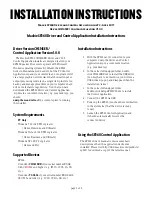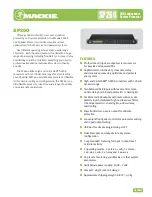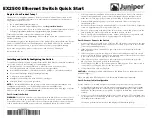
1-4
For simplicity, the descriptions and examples below involve only four fields of configuration BPDUs:
z
Root bridge ID (represented by device priority)
z
Root path cost (related to the rate of the link connecting the port)
z
Designated bridge ID (represented by device priority)
z
Designated port ID (represented by port name)
Calculation process of the STP algorithm
z
Initial state
Upon initialization of a device, each port generates a BPDU with itself as the root bridge, in which the
root path cost is 0, designated bridge ID is the device ID, and the designated port is the local port.
z
Selection of the optimum configuration BPDU
Each device sends out its configuration BPDU and receives configuration BPDUs from other devices.
Table 1-2
describes the process of selecting the optimum configuration BPDU.
Table 1-2
Selection of the optimum configuration BPDU
Step
Actions
1
Upon receiving a configuration BPDU on a port, the device performs the following:
z
If the received configuration BPDU has a lower priority than that of the configuration
BPDU generated by the port, the device discards the received configuration BPDU
and does not process the configuration BPDU of this port.
z
If the received configuration BPDU has a higher priority than that of the configuration
BPDU generated by the port, the device replaces the content of the configuration
BPDU generated by the port with the content of the received configuration BPDU.
2
The device compares the configuration BPDUs of all the ports and chooses the optimum
configuration BPDU.
The following are the principles of configuration BPDU comparison:
z
The configuration BPDU that has the lowest root bridge ID has the highest priority.
z
If all the configuration BPDUs have the same root bridge ID, their root path costs are compared.
Assume that the root path cost in a configuration BPDU plus the path cost of a receiving port is S.
The configuration BPDU with the smallest S value has the highest priority.
z
If all configuration BPDUs have the same ports value, their designated bridge IDs, designated port
IDs, and the IDs of the receiving ports are compared in sequence. The configuration BPDU
containing a smaller ID wins out.
z
Selection of the root bridge
Содержание S7902E
Страница 82: ...1 4 DeviceA interface tunnel 1 DeviceA Tunnel1 service loopback group 1 ...
Страница 200: ...1 11 DeviceB display vlan dynamic No dynamic vlans exist ...
Страница 494: ...ii Displaying and Maintaining Tunneling Configuration 1 45 Troubleshooting Tunneling Configuration 1 45 ...
Страница 598: ...ii ...
Страница 1757: ...4 9 ...
Страница 1770: ...6 4 ...
Страница 2017: ...2 11 Figure 2 3 SFTP client interface ...
Страница 2062: ...i Table of Contents 1 URPF Configuration 1 1 URPF Overview 1 1 What is URPF 1 1 How URPF Works 1 1 Configuring URPF 1 2 ...
Страница 2238: ...1 16 DeviceA cfd linktrace service instance 1 mep 1001 target mep 4002 ...
Страница 2442: ...2 4 Set the interval for sending Syslog or trap messages to 20 seconds Device mac address information interval 20 ...
















































